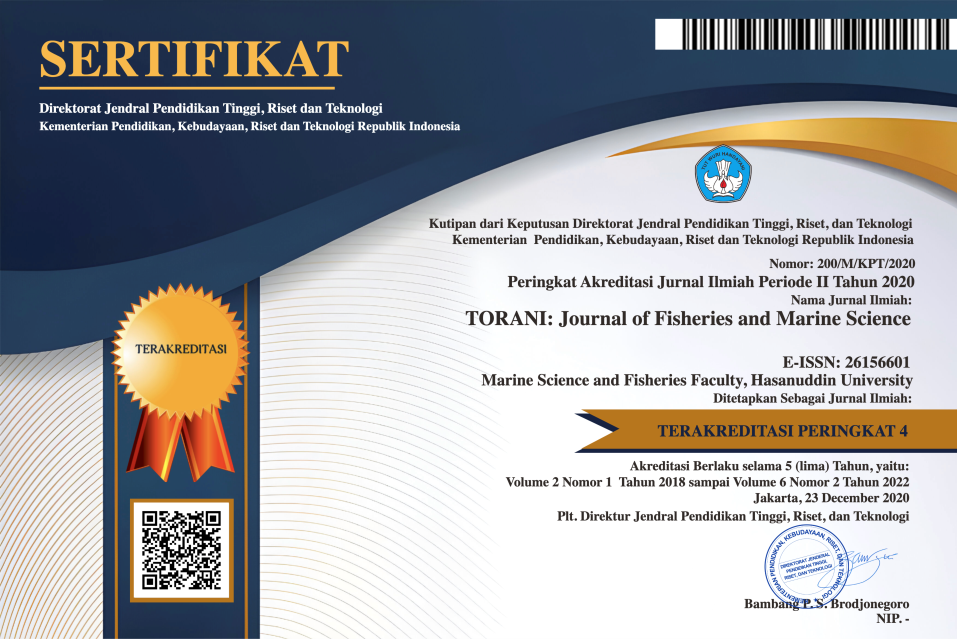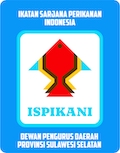Author Guidelines Peer Review Reviewers Focus and Scope Publication Ethics Copyright Notice Author(s) Fee Plagiarism Policy
Author Guidelines
Guideline for Preparing Manuscript
The manuscript should be typed using word processors (Microsoft Word) software. The font used throughout the paper is Times New Roman. The paper size is A4 (i.e., 210 x 297 mm), one-column format with a 2.5 cm margin at the top, a 2.5 cm margin at the bottom, a 3.0 cm margin on the left, and a 2.5 cm margin on the right. Lines are one-half spaced, justified. Page numbers should be included in the text located in the footer section of each page. Use of pronouns such as I, we is to be avoided.
Manuscript submitted to this journal should follow the heading below (Manuscript Template), except for the review article: Title; Authors Name; Authors Affiliation; Abstract; Keywords; Introduction; Materials and Methods; Results and Discussion; Conclusions; Acknowledgments; and References.
Download: Manuscript Template
Title [13pt, Times New Roman, Bold]
This is your opportunity to attract the reader’s attention. Remember that readers are the potential authors who will cite your article. Identify the main issue of the paper. Begin with the subject of the paper. The title should be accurate, unambiguous, specific, and complete. Do not contain infrequently-used abbreviations. The number of words in the title is no more than 12 words. The title of the paper should be in 13 pt bold Times New Roman and be centered. The title should have 0 pts space above and 12 pts below.
Example:
The Ecological Potential of Wild Orchids for in situ and ex-situ Conservation of Rare Species in Enrekang, South Sulawesi, Indonesia [13 pt, Times New Roman, bold]
Authors Name and Affiliations [12pt, Times New Roman, Reguler]
Write Author(s) names without title and professional positions such as Prof, Dr, Production Manager, etc. Do not abbreviate your last/family name. Always give your First and Last names. If you have one word name such as Achmad, write Achmad Achmad. Write clear affiliation of all Authors. Affiliation includes: name of department/unit, (faculty), name of university, address, country. Please indicate Corresponding Author (include email address) behind the name.
Author names should be in 12 pt Times New Roman regular with 6 pt above (before) and 6 pt below (after). Author addresses are super-scripted by numerals and centered over both columns of manuscripts. Author affiliations should be in 10 pt Times New Roman. The body of the text should commence 2 lines (24 points) below the last address.
Example:
Moh. Tauhid Umar (Corresponding author) Department of Fisheries, Faculty of Marine Science and Fisheries, Hasanuddin University. Jl. Perintis Kemerdekaan Km. 10 Makassar 90245, South Sulawesi, Indonesia E-mail: tauhid.umar72@gmail.com
Abstract [12pt, Times New Roman, Bold]
The abstract should be clear, concise, and descriptive. This abstract should provide a brief introduction to the problem, objective of the paper, followed by a statement regarding the methodology and a brief summary of results. The abstract should end with a comment on the significance of the results or a brief conclusion. Abstracts are written in 12 pt Times New Roman, preferably not more than 300 words.
Keywords: [12pt, Times New Roman, Bold]
Maximum of 5 keywords separated by semicolon (;), crucial to the appropriate indexing of the papers, are to be given. eg: Wild orchid; ecology conservation; important value; diversity index.
Introduction [12pt, Times New Roman, Bold]
The introduction part (recommended length: 500-1000 words) gives the reader an enticing glimpse of what is to come. It must grab the reader’s attention by stimulating attention, interest, desire, and action. In other words, the introduction must effectively “sell” the manuscript.
The introduction generally consists of: a broad statement about the theme or topic of the study; summary of available literature and cites the most important studies that are relevant to the current research; a statement about controversies, gaps, inconsistencies in the literature that the current study will address; a statement about problems/questions to be addressed in the study or objectives of the study. You can also state at the end of the introduction outline of the structure of the rest of the article.
Materials and Methods [12pt, Times New Roman, Bold]
The materials and methods section (recommended: 500-1000 words) describes materials used in research and steps followed in the execution of the study. A brief justification for the method used is also stated so the readers can evaluate the appropriateness of the method, reliability, and validity of the results.
Results and Discussion [12pt, Times New Roman, Bold]
Results should be clear and concise. The results should summarize (scientific) findings rather than providing data in great detail. Please highlight differences between your results or findings and the previous publications by other researchers.
The discussion should explore the significance of the results of the work, not repeat them. Separation or combination of Results and Discussion section is accepted. Avoid extensive citations and discussion of published literature.
In the discussion, it is the most important section of your article. Here you get the chance to sell your data. Make the discussion corresponding to the results, but do not reiterate the results. Often should begin with a brief summary of the main scientific findings (not experimental results). The following components should be covered in the discussion: How do your results relate to the original question or objectives outlined in the Introduction section (what)? Do you provide interpretation scientifically for each of your results or findings presented (why)? Are your results consistent with what other investigators have reported (what else)? Or are there any differences?
1. Tables
Tables are sequentially numbered with the table title and number above the table. Tables should be centered in the column or on the page. Tables should be followed by a line space (12pt). Elements of a table should be single-spaced, however, double spacing can be used to show groupings of data or to separate parts within the table. Table headings should be in 10pt bold. Tables are referred to in the text by the table number (show Tabel 1 in Template). Do not show vertical lines in the table. There is only a horizontal line that should be shown within the table.
2. Figures
Figures are sequentially numbered commencing at 1 with the figure title and number below the figure as shown in Figure 1 at the Template. Detailed recommendations for figures are as follows:
- Ensure that figures are clear and legible with typed letterings.
- Black & white or colored figures are allowed.
- If a figure spans two columns, it should be placed at the top or bottom of a page.
Hard copy illustrations should, preferably, be scanned and included in the electronic version of the submission in an appropriate format as follows:
- BMP - Microsoft bitmap file
- JPEG - Joint Photographic Experts Group
- PNG – Portable Network Graphics
The following files are permissible: a) Microsoft Graph; b) Microsoft Draw
3. Equations
Equations should be numbered serially within parentheses as shown in Equation (1). The equation should be prepared using MS Equation Editor (not in image format). The equation number is to be placed at the extreme right side.
4. Units, Abbreviations and Symbols
Metric units are preferred. Define abbreviations and symbols at the first time as they are introduced in the text.
Conclusions [12pt, Times New Roman, Bold]
Conclusions should answer the objectives of research. Tells how your work advances the field from the present state of knowledge. Without clear Conclusions, reviewers and readers will find it difficult to judge the work, and whether or not it merits publication in the journal. Do not repeat the Abstract, or just list experimental results. Provide a clear scientific justification for your work, and indicate possible applications and extensions. You should also suggest future works and/or policy implications.
Acknowledgment [12pt, Times New Roman, Bold]
Recognize those who helped in the research, especially funding supporters of your research. Include individuals who have assisted you in your study: Advisors, Financial supporters, or many other supporters, i.e. Proofreaders, Typists, and Suppliers who may have given materials.
References [12pt, Times New Roman, Bold]
Cite the main scientific publications on which your work is based. Cite only items that you have read. Do not inflate the manuscript with too many references. Avoid excessive self‐citations. Avoid excessive citations of publications from the same region. Check each reference against the original source (author's name, volume, issue, year, DOI Number). Please use Reference Manager Applications like EndNote, Mendeley, Zotero, etc. Use other published articles in the same journal as models.
All publications cited in the text should be included as a list of references. References are listed alphabetically. Please ensure that every reference cited in the text is also present in the reference list (and vice versa). Any references cited in the abstract must be given in full. Unpublished results and personal communications are not recommended in the reference list but may be mentioned in the text. If these references are included in the reference list, they should follow the standard reference style of the journal and should include a substitution of the publication date with either “Unpublished results” or “Personal communication”. Citation of a reference as 'in print' implies that the item has been accepted for publication.
References in the text should be in full if they have one or two authors (e.g.: Jusoff, 2013; Jusoff and Arsyad, 2013); in the case of more than three or multiple authors, they should be cited as Jusoff et al. (2013) or (Jusoff et al., 2013). Full References should be provided in the References section.
Journal Articles:
Ouyang, D., J. Bartholic and J. Selegean. (2005). Assessing Sediment Loading from Agricultural Croplands in the Great Lakes Basin. Journal of American Science, 1(2): 14-21.
Arsyad, M. and S. Yusuf. (2008). Assessing the Impact of Oil Prices and Interest Rates Policies: the case of Indonesian Cocoa. Ryukoku Journal of Economic Studies, 48(1):65-92.
A Book:
Durbin, R., S.R. Eddy, A. Krogh and G. Mitchison. (1999). Biological Sequence Analysis: Probabilistic Models of Proteins and Nucleic Acids. Cambridge University Press.
A Chapter in a Book:
Leach, J. (1993). Impacts of the Zebra Mussel (Dreissena polymorpha) on Water Quality and Fish Spawning Reefs of Western Lake Erie. In Zebra Mussels: Biology, Impacts and Control, Eds., Nalepa, T. and D. Schloesser. Ann Arbor, MI: Lewis Publishers, pp: 381-397.
A Report:
Makarewicz, J.C., T. Lewis and P. Bertram. (1995). Epilimnetic Phytoplankton and Zooplankton Biomass and Species Composition in Lake Michigan, 1983-1992. U.S. EPA Great Lakes National Program, Chicago, IL. EPA 905-R-95-009.
Conference Proceedings:
Stock, A. (2004). Signal Transduction in Bacteria. In the Proceedings of the 2004 Markey Scholars Conference, pp: 80-89.
A Thesis:
Arsyad, M. (2010). The Dynamics of Cocoa Smallholders in Indonesia: An Application of Path Analysis for Poverty Reduction. Ph.D. Thesis, Ryukoku University, Kyoto.














